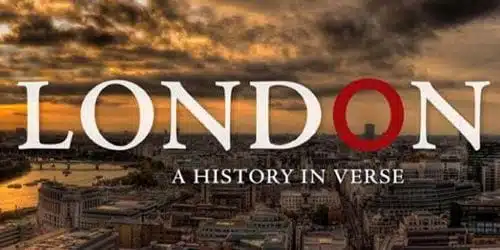
Discussion of book jackets might be a poor place to start a review, but the deep crimson circle that is the second O on the cover of London: A History in Verse seems specially significant. Set off from its white counterparts in the title, running across the horizon of a cityscape at sunrise/set, the circle takes on a certain symbolic potential. A sun, perhaps? Too obvious. Another London eye, the iconic, laconic Ferris wheel that rotates tourists above the city? If so, what’s suggested is a cycle of looking, returning back to its origins in a circular path of reflection.
That seems appropriate for this anthology, which offers London-centric poetry that spans more than 600 years. From the Middle-Age likes of Langland and Chaucer to modern day, the anthology is a kind of centrifuge, gathering to itself what editor Mark Ford describes as “London poems”. In the book’s preface, Ford explains that he “developed a rather rigorous definition of what constitutes a London poem”, but then goes on to immediately undercut that notion of rigor with his criteria for admittance: “it must contain explicit reference to London, or to places in London, or to events that happened in London, or […] to artworks housed in London”. So, in order to get in, a poem must evince some geographical link, however tenuous, to the city.
While this may seem like a criticism of the organizing logic of the anthology, it’s instead an appreciation of the decided looseness that, by definition, must accompany a project of this scope. To cross hundreds of years and millions of lives, to tell a city’s history (let alone to tell it through verse) is to usher in a kind of plenitude that will resist consistency and narrative at every turn. Of course, so much depends upon… a preposition. That this book is London: A History In Verse, rather than a history Of verse, acknowledges that this is an act of poetic sampling, as opposed to an organized “history” of the art. To Ford’s credit, no such trappings or contrivances are attempted here.
Instead, what’s on offer is an exercise is historical-cultural geography. The experience of reading it is much like that of stepping out of King’s Cross station and strolling the city’s streets. Walk long enough, read deeply enough, and you’ll be immersed in impressions of beauty, grime, humor, violence – often simultaneously. If this book succeeds as a celebration, it is only insofar as it admits everything, like the city itself.
So, we are treated to John Gower’s 14th century royalism, as he dedicates in “Confessio Amantis”, “A book for King Richarades sake/To whom bilangeth my ligeance”. At the other end of the chrono-linguistic spectrum, Linton Kwesi Johnson writes in “Sonny’s Lettah”: “Mama,/ I really did try mi bes,/ but nondiles/ mi sarry fi tell yu she/ poor likkle Jim get arres” (2006). In between, the city is courted with anonymous praise as a “Sovereign of cities, seemliest in sight” (c.1500), and a “justly queen of cities crowned” (1793). A century later, another anonymous poet notes “My eye is pleased with all it meets/ In Bloomsbury” (1893).
Of course, (tellingly anonymous) poetic appreciations of the capital of “Old Blighty” are in the decided minority here. Complaints against London run from the legal (like the Earl of Surrey’s “London, hast thou accusèd me”) to the postcolonial (with “tugs chirring up a devalued empire” in Derek Walcott’s Omeros). Urban claustrophobia abounds as well. The speaker in John Donne’s “To Mr. E.G.” is “too much overseen”; in “London”, William Blake “mark[s] in every face I meet/ Marks of weakness, marks of woe”; and Keats claims to be “one who has been long in city pent”. For T.S. Eliot, the drain of London is metaphysical: “Here is a place of disaffection” (“Burnt Norton”).
Poets like Keats and Blake express the kind of angst that is mass-produced by any major city, not just London. As well, some selections are tethered to the city by the lightest of strings. A selection by Yeats simply notes “I sat, a solitary man/ In a crowded London shop”, while Ashbery’s “The Tower of London” (in typical Ashberian style) is more concerned with a movie about the Tower, and the actors who were in it, than the actual city landmark itself.
Still, however faint these connections may be, the city’s presence throughout the 700 pages of poetry collected here is undeniable. To return to that red circle, London exists at the center of a poetic orbit (and seemingly always has done). Naturally, political, economic, and historical trends have all contributed to that pull, but the city’s artistic gravity is no less important for all that.
This anthology traces the forces of time through language, a valuable exercise for anyone interested in London, or poetry, or that rich confluence of art and history. As John Davidson’s “London” perhaps best describes, only a rollicking, vibrant center could produce such innumerable wealth: “An ever-muttering prisoned storm / The heart of London beating warm”.
